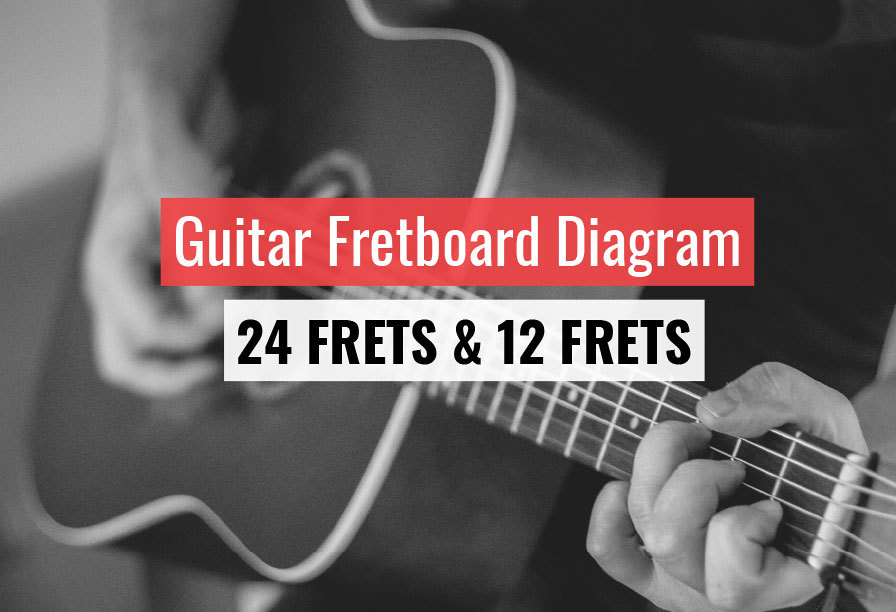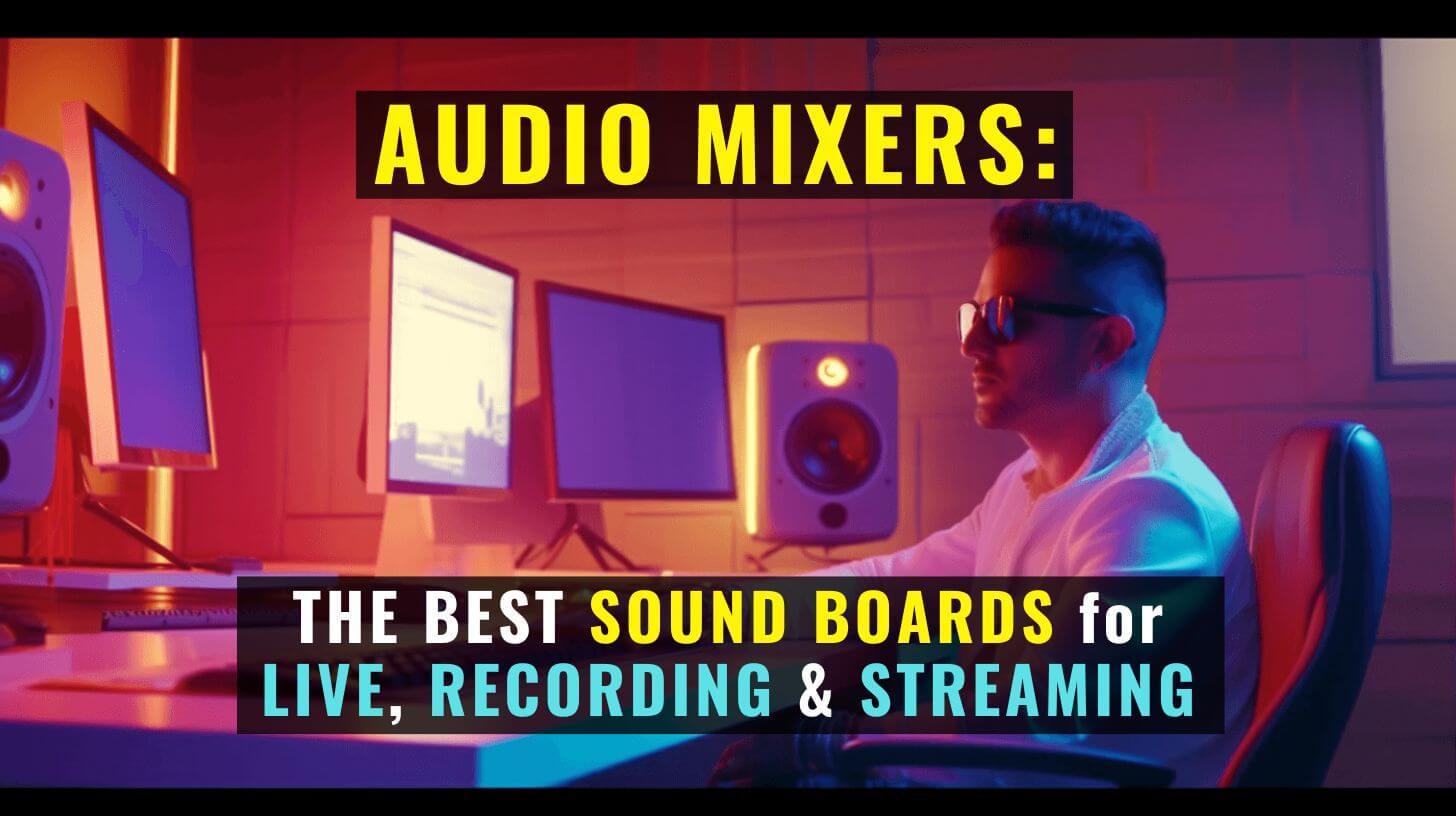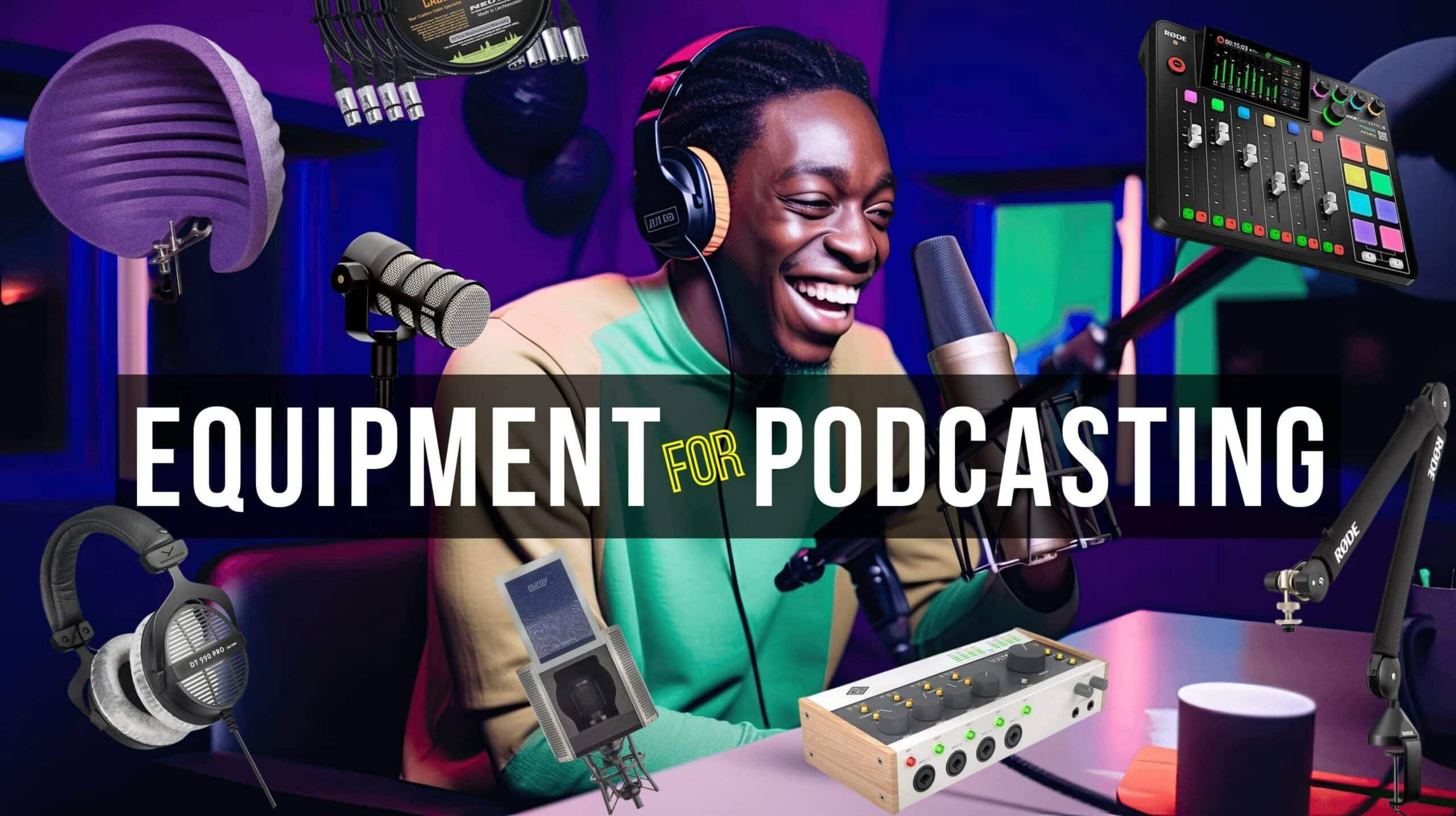
Guitar Fretboard Diagram: (12 & 24 Fret Charts)
Free Guitar Fretboard diagram PDF for beginners showing all fretboard notes with 24 frets & 12 fret diagrams to help you understand the guitar neck…
Sound boards, mixing consoles, analog and digital mixers: In this guide, we rank and review the best audio mixers for live, recording and streaming.
With this easy-to-navigate review, you can choose the right sound mixer for your skill level and budget. Whether you’re looking for a 32-channel digital mixer, a 4-channel small mixer for your home studio or a powered mixer for professional use, we’ve got you covered.
The QSC TouchMix 16 is not only powerful but also easy to use. Its touchscreen makes it simple to make adjustments on the fly. TouchMix is a great choice for rookies and experienced users alike.
Experience seamless audio control with the classic Behringer X32. This 32-channel digital console offers studio-grade sound quality, making it a popular choice for studio and live performances.
RodeCaster Pro II mixer is a top choice for podcasters and streamers. It is versatile for standalone or computer use, with multiple inputs, headphone outputs, and Bluetooth connectivity.

Audio mixers (aka sound mixers and sound consoles) are a staple of any recording studio and are vital tools if you produce music, podcasts, or videos.
Sound mixers allow you to control the levels, panning, and EQ of multiple audio signals and often include built-in effects, such as compression and reverb.
In this blog post, we show you how to choose the perfect mixing console for your project, whether it’s for professional live recording, streaming, or home studio use.
We compare the 13 best sound mixers from top brands like Behringer, Tascam, Mackie, Yamaha, and more. You’ll learn about the features and benefits of each one and how to get the most out of them.
👉 We’ve prepared a handy audio mixer FAQs section at the end of the article, where we answer your common sound mixer-related questions, like What is an audio mixer? Do I need a mixer board? Mixer vs Audio Interface and DAW vs Audio Mixer. Check it out and to clear any confusion.
That being said, let’s get to the mixers!
The best audio mixers:
The PreSonus StudioLive 32SC is a versatile mixer for everything from live performance to in-ear monitoring. It has 32 channels, motorised faders and a sleek touchscreen.
If you’re a serious sound engineer or producer running a mid-sized live event, the PreSonus StudioLive 32S mixer is your go-to. This console has 40 mixing channels, 26 mix buses, and 286 simultaneous processors, which can handle even the most complex sound setups.
The PreSonus 32C mixer has 32 XMAX preamps, studio-grade effects, and 64×64 USB recording, which give you crystal-clear sound.
You can also use the analog connectors and Fat Channel plug-ins on each channel to create the sound of analog gear, as they have ten EQ and compressor models.
However, it’s important to note that this mixer is not beginner-friendly due to its challenging learning curve.
Number of Tracks: 32
Digital or Analog: Digital
Audio resolution: Up to 24-bit/192kHz
Powered or Unpowered: Powered
Phantom power: Yes
Analogue inputs: 32 (42 overall)
Analogue outputs: 22
Effects: Effects: Yes. FLEX FX multi-effects processor with 4 slots and 16 presets
The SSL SiX is a pro-sounding mixing console with studio-grade preamps and high-quality FX, making it the perfect prosumer project studio upgrade.
The SSL SiX Desktop Mixer is a compact, high-quality analog console designed to cater to the needs of the most demanding audio creators. SSL SiX has ultra-clean ‘SuperAnalogue’ circuitry throughout, derived directly from existing SSL consoles.
The SiX’s preamps produce clean and low noise, even at high gain. It has six input channels, two stereo line input channels, and mix bus compression based on their legendary G series technology.
Whether you’re capturing the nuances of a delicate acoustic guitar or the raw power of an electric bass, the SiX ensures every note is captured with clarity and precision.
The SSL SiX mixer proves that exceptional sound quality and professional-grade features don’t have to come at a premium. Its compact design and impressive features make it an ideal choice for recording, post-production and live.
Number of Tracks: 6
Digital or Analog: Analog
Audio resolution: 24-bit/192 kHz
Powered or Unpowered: Powered
Phantom power: Yes
Analogue inputs: 6
Analogue outputs: 6
Effects: Yes. EQ and Mix bus compression.
High-quality analog audio with built-in digital effects and a USB recording interface makes the Tascam 12 audio mixer a complete recording solution for musicians and producers.
If you’re looking for a versatile audio mixer that can do more than mix, check out the Tascam Model 12. It’s an all-in-one device that combines a mixer, recorder, interface, and controller.
With 10 flexible inputs, each featuring a one-knob compressor and EQ and 16 built-in effects, the Model 12 provides all you need to create professional-quality recordings and mixes.
Tascam 12 has a built-in 12-track recorder that can record and play back WAV files of up to 24-bit/48 kHz quality directly to an SD card. It also has a unique podcasting capability that includes a mix-minus function and a smartphone input.
Not only does the Tascam 12 mixer have a sleek and vintage design, but it can also function as a DAW controller. The build quality is sturdy, but just a heads up – it’s not the lightest mixer out there, weighing in at 4.3 kg.
However, if you don’t mind a little extra weight, this Tascam mixer will make a great addition to your setup.
Number of Tracks: 12-track recorder and 10-track playback
Digital or Analog: Analog mixer with digital recorder
Audio resolution: 24-bit/48 kHz
Powered or Unpowered: Powered
Phantom power: Yes
Analogue inputs: 10
Analogue outputs: 6
Effects: Yes. Built-in effects processor with 16 presets
The Yamaha MG10XU is an inexpensive, compact, sturdy mixer with great audio quality, user-friendly controls, digital effects, and USB interface for live streaming and recording.
For project studios and mobile recording setups seeking a versatile and affordable mixer, the Yamaha MG10XU mixer is a top choice.
This compact and durable sound Yamaha mixer packs in impressive sound quality, intuitive controls, and a range of features for a small price tag, making it ideal for creating professional-sounding audio productions.
The SPX digital effects processor offers a variety of reverb, delay, and chorus effects, adding versatility and a touch of polish to the overall sound of the mixer.
The Yamaha MG10 mixer offers a range of flexible connectivity options, including XLR and TRS inputs, as well as RCA connectors, so you can connect microphones, instruments, and external devices with ease.
If simplicity and budget are your jam, the MG10XU mixing board is a top-notch choice; it’s user-friendly without burning a hole in your pocket and can handle most mixing tasks.
Number of Tracks: 10
Digital or Analog: Analog
Audio resolution: 48 kHz/24-bit
Powered or Unpowered: Powered
Phantom power: Yes
Analogue inputs: 10
Analogue outputs: 6
Effects: Yes. 24 SPX
Experience seamless audio control with the classic Behringer X32. This 32-channel digital console offers studio-grade sound quality, making it a popular choice for studio and live performances.
The Behringer X32 is an audio engineer’s dream come true. It delivers pristine audio with next to zero latency, thanks to its 40-bit floating-point DSP.
The flagship X32 Behringer mixer is fully automatable and features DAW control to make mixing seamless. The 7″ Color TFT display and dynamic LCD Scribble Strips make channel navigation easy.
Each of the 16 mix busses of the X-32 comes with an insert, a 6-band parametric EQ, and compressors, giving you precise sound shaping tools. The virtual FX rack includes high-end simulations like Lexicon 480L and PCM70 to add an extra dimension to your sound.
The X32 comes with 16 analog XLR outputs, adjustable delays, and a USB port for direct recording, making it a true powerhouse mixing console. If you’re looking to elevate your audio game, the Behringer X32 is the perfect choice.
Number of Tracks: 32
Digital or Analog: Digital
Audio resolution: 24-bit/48kHz
Powered or Unpowered: Powered
Phantom power: Yes
Analogue inputs: 32-64
Analogue outputs: 22
Effects: Effects: Yes. X32 has a wide range of built-in effects, including EQ, dynamics, and various effects processors
Experience top-notch Bose sound quality and effects with the T4S 4-channel audio mixer. Compact and user-friendly, it’s tailor-made for musicians and audio creators on the move.
The Bose T4S ToneMatch 4-Channel Mixer is a blessing for musicians, sound engineers and DJs on the go. With its user-friendly interface and handy presets, it’s a perfect fit for those who don’t want to delve deep into EQ adjustments.
The Bose T4S is the ideal upgrade to the Bose T1 and controls Bose PA systems like the L1 with ease. Additionally, the mixer has four combo jacks for microphones/instruments and range of effects to enhance the overall sound.
This 4-track Bose sound console is impressive, especially with its ToneMatch processing technology that automatically adjusts the mixer’s settings according to the instrument or vocal being plugged in, resulting in consistently high-quality sound.
Operating the Bose mixer is easy due to the clearly labelled controls and easy-to-read LED displays, and the mixer’s storable scenes also allow for quick recall of preferred settings. If you’re looking for a portable 4-track mixer that’s easy to use, the Bose T4S is your guy.
Number of Tracks: 4
Digital or Analog: Digital
Audio resolution: 24-bit/48kHz
Powered or Unpowered: Powered
Phantom power: Yes
Analogue inputs: 6
Analogue outputs: 6
Effects: Effects: Yes. EQ, dynamic, and effects per channel
RodeCaster Pro II mixer is a top choice for podcasters and streamers. It’s versatile for standalone or computer use, with multiple inputs, headphone outputs, and Bluetooth connectivity.
If you’re looking for a mixer that can handle the demands of both podcasting and streaming, the Rode RodeCaster Pro II is a great option.
Its standalone operation allows you to use it without a computer, making it perfect for capturing audio on the go. When you’re ready to edit and mix your podcast or live stream, you can easily connect the RodeCaster Pro II to your computer for seamless integration with your editing software.
RodeCaster Pro II is also straightforward to use. The 5.5-inch touchscreen is responsive and intuitive, with plenty of hands-on controls for quick adjustments.
The Smart Pads make sound effects triggering a piece of cake, and with the addition of two bank-scrolling buttons, you’ll spend less time in menus and more time creating.
The Rodecaster Pro 2 offers exceptional value, is feature-packed, user-friendly, and produces high-quality sound. It’s a smart investment for serious podcasters, YouTubers and broadcasters.
Number of Tracks: 4
Digital or Analog: Digital
Audio resolution: 24-bit/48kHz
Powered or Unpowered: Powered USB-C
Phantom power: Yes
Analogue inputs: 4
Analogue outputs: 6
Effects: Yes. Various, including compressor, noise gate, de-esser, and three-band EQ
The Soundcraft Signature 22-input analog mixer delivers high-quality sound with its iconic Soundcraft® Ghost mic preamps and Sapphyre British EQ.
Looking for a high-end analog mixer that delivers great audio quality and has lots of inputs? Check out the Soundcraft Signature 22MTK 22-input mixer.
The Soundcraft 22MTK delivers pristine audio with its Ghost mic preamps, versatile Sapphyre Asymmetric EQ, and studio-grade effects, making it an ideal choice for both live sound and studio production.
The Soundcraft mixer has an ultra-low latency USB interface for seamless multi-track recording, switchable Hi-Z inputs to connect instruments directly, and premium-quality faders and flexible GB® Series audio routing for precise control over your mix.
The Soundcraft Signature 22MTK mixing console may be too large for some users, but it’s an excellent choice for producers and sound engineers who are looking for an analog mixer with a broad range of features and unparalleled sound quality.
Number of Tracks: 24
Digital or Analog: Analog
Audio resolution: 24-bit/48kHz
Powered or Unpowered: Powered USB-C
Phantom power: Yes
Analogue inputs: 22
Analogue outputs: 22
Effects: Yes, Lexicon® Effects Engine effects
The Zoom L8 is a great option for anyone who is new to audio recording. It’s easy to use and has all the features you need to get started. It’s also very portable, so you can take it with you wherever you go.
If you’re looking for a reliable, inexpensive mixer, the Zoom LiveTrak L-8 is one to check out. Its portability and ability to run on USB power or batteries make it an ideal choice for location recording.
Zoom L8 has the capability to store audio on SD cards, and its six high-performance preamps are equipped with phantom power and a 3-band EQ, allowing for clear sound quality.
Plug in your instruments and devices directly for hassle-free recording. The Zoom L8 audio mixer allows you to capture up to 12 tracks simultaneously at a high-quality 24-bit/96kHz resolution, with the convenience of overdubbing and punch-ins.
The Zoom L8 mixer provides three separate monitor mixes, ensuring each performer receives their ideal sound. It is an affordable all-in-one solution for your podcast, live stream, or music recording needs.
Number of Tracks: 12
Digital or Analog: Digital
Audio resolution: 44.1/48/96 kHz.
Powered or Unpowered: Powered by AA batteries or a USB power supply
Phantom power: Yes
Analogue inputs: 8
Analogue outputs: 5
Effects: Yes. FX include reverb, delay and compression
The Behringer X32 Rack mixer offers excellent audio quality in a compact, rack-mountable design. This beast of a mixer is perfect for live sound and studio use with 32 channels.
Behringer X32 Rack mixer is a fader-less version of the popular X32 mixing board designed for convenient storage and portability, whether a permanent installation or a part of a fly rig.
The X32 Rack has several impressive features, including 16 Midas-designed microphone preamps, almost non-existent overall latency (0.8 msec), a virtual FX rack with 8 true-stereo FX slots that have high-end simulations like Lexicon 480L, PCM70, Quantec QRS, and more. Additionally, it has 100 internal total recall scenes.
The Behringer X32 rack mount is designed for those who want to take control of their mix without the bulk of a standard mixing console. The dedicated app for iPad or Windows tablets makes it easy to manage your mix from anywhere in the venue or studio.
With a single screen that combines channel faders, DCAs, and bus faders, you can easily adjust the x32’s parameters, create scenes, and fine-tune your sound.
Whether you’re a touring sound engineer or want to step up your home recording studio game, the X32 Rack mixer will improve your workflow and deliver unmatched sound quality.
Number of Tracks: 32
Digital or Analog: Digital
Audio resolution: 24-bit @ 44.1/48 kHz
Powered or Unpowered: Powered
Phantom power: Yes
Analogue inputs: 16
Analogue outputs: 8
Effects: Yes. Over 50 integrated FX plug-ins, including reverbs, delays, compressors, and EQs
The QSC TouchMix 16 is not only powerful but also easy to use. Its touchscreen makes it simple to make adjustments on the fly. TouchMix is a great choice for rookies and experienced users alike.
The QSC TouchMix 16 is a digital mixer with intuitive touchscreen control. It delivers crisp sound quality and versatile mixing capabilities for recording, rehearsals, and live performances.
The TouchMix 16 mixer has 16 input channels, 14 aux sends, and a range of effects, making it suitable for most setups. Its Anti-Feedback and Room Tuning Wizards eliminate the guesswork of achieving excellent sound quality in any environment, even for those new to recording.
The QSC mixer features high-quality mic preamps and an excellent compressor, providing precise control and flexibility in shaping your sound.
In summary, the QSC TouchMix 16 packs powerful processing into a compact and user-friendly mixer, catering to both beginners and experienced users alike.
Number of Tracks: 16
Digital or Analog: Digital
Audio resolution: 24-Bit at 44.1/48 kHz
Powered or Unpowered: Powered
Phantom power: Yes
Analogue inputs: 20
Analogue outputs: 8
Effects: Yes. 4 Professional Effect-Engines including Reverb, Echo, Delay, Chorus
GoXLR 4-Channel USB mixer is a must-have for streamers, podcasters, and musicians. It lets you fine-tune your audio, add voice effects, and make your content sound pro-level.
GoXLR by TC Helicon is a 4-channel USB sound mixer that’s popular for streamers of all levels. You get four channels for your microphone, music, chat, and external audio, which is handy for controlling your sound.
The GoXLR has motorised faders as one of its standout features. The faders make it easy to adjust your audio levels precisely, and they even come with LCD scribble strips so you can label your channels and keep tabs on your settings.
Another nifty feature of GoXLR is the built-in vocal effects processor. You can add effects to your voice, like reverb, echo, pitch shift, and compression.
The one thing to remember is that the GoXLR mixer gives you only four faders, so if you need more, another great alternative to take a gander at is the QSC TouchMix 16 mixer.
Number of Tracks: 4
Digital or Analog: Digital
Audio resolution: 24-bit/48kHz
Powered or Unpowered: Powered
Phantom power: Yes
Analogue inputs: 1 x XLR, balanced
Analogue outputs: 1 x XLR, balanced; 1 x 3.5mm TRS headphone output
Effects: Yes. Voice effects, customisable RGB lighting, soundboard, and sampler
A mixing board, also known as an audio mixer or sound mixer, is a device that allows you to adjust the volume, tone, and effects of multiple audio sources and combine them into a single output.
A mixing board is vital for live sound, recording, broadcasting, podcasting, and music production.
An audio interface and a mixer are both important pieces of equipment for audio production, but they serve different purposes.
The difference between a mixer and an audio interface (aka sound card) is that an audio interface converts analog audio signals into digital signals that a computer can understand.
Conversely, a mixer is a device used to combine and manipulate multiple audio signals. A mixer console mixes audio for live sound, recording, broadcasting, podcasting, or music production.
In most cases, you will need an audio interface and a mixer to record and mix audio effectively. The audio interface will connect your instruments and microphones to your computer, while the mixer will allow you to combine and control the different audio signals.
A DAW, or digital audio workstation, is a software program used to record, edit, and mix audio. A mixing board, on the other hand, (also known as an audio mixer or console) is a physical hardware device used to adjust and combine audio signals.
Audio mixers typically have several input channels, each with its own controls for volume, panning, equalization, and other effects.
Audio mixers are typically used for live sound mixing, recording live audio, and mixing multi-track recording projects. While both tools can create professional-quality audio, they serve different purposes.
A mixer is essential if you’re involved in music production, live events, or recording. A mixer allows you to manage audio quality, seamlessly handle multiple sources, and achieve a professional-grade audio output.
The following are examples of users who require an audio mixer:
Musicians, producers and sound engineers rely on mixers to balance instrument levels, shape tones, and create effects for live performances and studio recordings.
Podcasters and video creators use mixers to balance audio levels, enhance voice quality, add effects, and integrate background elements for professional sound.
Live front-of-house and monitor engineers utilise mixers to blend multiple audio sources, optimise sound for different venues, eliminate audio issues, and create dynamic live mixes.
Some of the best audio mixers for music production and live performances are Behringer X32, SSL SiX, PresonusLive 32C, and Tascam Model 12. Learn more about each sound console below:
The Behringer X32 is a digital mixer renowned for its exceptional audio quality and extensive range of features. With 32 channels, this digital console provides seamless audio control and studio-grade sound quality, making it an excellent choice for live and studio work.
→ Get Behringer X32: Amazon | Gear4Music | Thomann
The PreSonus StudioLive 32SC is a versatile digital mixer with 32 channels, motorised faders, and a sleek touchscreen. This PreSonus mixer is well known for its crisp sound quality, making it ideal for live performances and in-ear monitoring.
→ Get PreSonus StudioLive 32SC: Amazon | Guitar Center | Gear4Music
The Tascam Model 12 mixes analog sound with digital recording capabilities for maximum convenience and flexibility. The mixer features a USB audio interface, MIDI connectivity, DAW control functions, and podcasting capabilities, including mix-minus and smartphone input.
→ Get Tascam Model 12: Amazon | Guitar Center | Thomann
If you’re on a budget and are looking for an affordable audio mixer, consider these fantastic beginner-friendly sound mixers:
Zoom LiveTrak L-8 Mixer is an easy-to-use digital mixer that is a great option for budget-conscious musicians, producers and podcasters. L8 mixer has 8 channels and also includes a built-in effects processor with 13 presets and USB connectivity.
→ Get Zoom LiveTrak L-8: Amazon | Gear4Music | Thomann
For project studios and mobile recording setups seeking a versatile and affordable mixer, the 10-channel Yamaha MG10XU sound mixer is a top choice.
This compact and durable mixer packs impressive sound quality, intuitive controls, and a range of features that make it ideal for creating professional-sounding audio productions at a small price.
→ Get Yamaha MG19XU: Amazon | Guitar Center | Gear4Music
There are many great mixers for streaming on the market, each with its own strengths and weaknesses. Some of the most popular mixers for streaming include GoXLR and the RodeCaster Pro 2:
Rode RodeCaster Pro II: Whether recording a podcast, producing a radio show, or streaming live, the RodeCaster sound mixer has everything you need to create professional-sounding audio.
→ Get RodeCaster 2: Amazon | Guitar Center | Thomann
GoXLR: The GoXLR 4-Channel USB broadcast mixer is a must-have for streamers, podcasters, and YouTubers. It lets you fine-tune your audio, add cool voice effects, and make your content sound pro-level.
→ Get GoXLR: Amazon | Gear4Music | Thomann
A mixing board is a device used to blend and adjust the levels of audio signals. Depending on the user’s preference, the specific function, or the design of the equipment, a mixing board can have different names.
Some common names for a mixing board include mixing console, audio mixer, mixer, sound mixer, mixing desk, or soundboard. It’s fascinating how one device can have so many different names.
There are three main types of mixing consoles: analog, digital, and hybrid:
The different names for an audio mixer are often used interchangeably in the audio industry.
If you’re looking for an audio mixer, you’ve just discovered the best mixers on the market for studio recording, live performance, podcasting and more.
Whether you’re an experienced audio engineer or a budding musician, having the right audio mixer can make a world of difference in the quality of your productions.
With its ability to blend multiple audio sources, apply effects, and optimise sound for different environments, an audio mixer is a versatile tool that can elevate your studio and live creations to a pro level.
With these top-notch mixers, you’re on the path to creating high-quality audio.
Have fun mixing!

Free Guitar Fretboard diagram PDF for beginners showing all fretboard notes with 24 frets & 12 fret diagrams to help you understand the guitar neck…

Podcasting equipment buyers guide that’ll help you get THE best podcast setup! Shure SM7b to Rode NT1 A to DT 990 PRO; discover the essential studio…

Find out what music theory guitar players should learn. Beginners to experienced – from Chord construction to key signatures, we break it down…